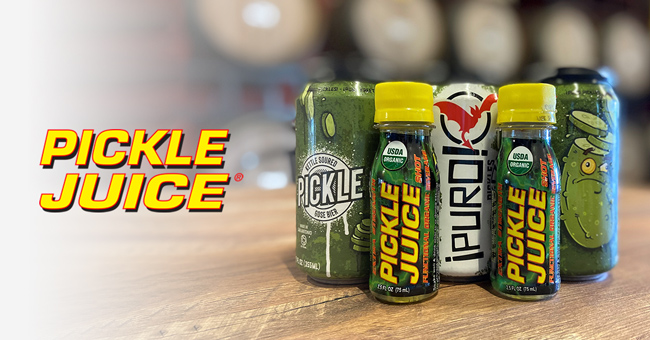The idea of drinking “Pickle Juice” may raise a lot of people’s eyebrows, and it’s a reaction The Pickle Juice Company is no stranger to. But as consumer awareness around the functional benefits of organic pickle juice-based drinks grows, the Texas-based beverage company is rapidly transforming to a broad-platform, international brand.
Founded in 2001 as a recovery drink sold almost exclusively to sports teams, Pickle Juice has sought to leverage its association with reducing muscle cramps to carve out space in the global market as a functional sports and recovery beverage with offices in Australia, South Africa and, in the near future, Europe. According to Filip Keuppens, VP of global sales and marketing for Pickle Juice, as the ingredient has grown in popularity among high intensity athletes, rising consumer awareness of the benefits has allowed the brand to expand into mainstream retail.
“It’s really exciting that before our own eyes were sort of evolving into this broader company that’s based on our knowledge of the future, if you will, of functional products and consumables,” Keuppens said.
The brand’s core line is available in several formats, including 2.5 oz. shots (its primary mainstream-facing SKU), 8 oz. and 12 oz. bottles, 1 gallon jugs and 20 Liter bag-in-boxes. The brand also offers a “Pickle Juice Chaser” mixer in 1 Liter bottles, intended for sales to bars and restaurants.
Over the past year, Pickle Juice has embraced collaborations as a means of expanding its platform and getting pickle-flavored beverages into new hands. Last fall, the company partnered with Miracle Seltzer and cable network Adult Swim to produce a “Pickle Rick” sparkling water flavor, referencing a popular episode of the show “Rick & Morty” that spawned a bevy of memes and tie-in merchandise. The product is available on Miracle Seltzer’s website for $24 per 12-pack of 10 oz. cans.
In February, the company worked with San Antonio, Texas-based brewery Freetail Brewing Company to develop a pickle flavored gose bier. According to Keuppens, the beverage became the top selling craft beer in H-E-B stores within a month of the rollout.
Keuppens said Pickle Juice is “very selective and strategic” in its partnerships, and is wary of the company being perceived as an ingredients supplier. He noted that as pickle brine has gained attention as a healthy ingredient, the Pickle Juice brand has risked being genericized (a la Thermos or Kleenex) and the company has had to become extra conscious of the quality and positioning of collaborations.
“We’ve had plenty of opportunities [for partnerships] that we’ve passed on, because we tell folks that we’re not a commodity, we’re not an ingredients company, we’re a brand,” he said. “So if we are going to do any partnership, we require that our brand be present on the packaging and be part of the narrative.”
As Pickle Juice looks beyond its hero ingredient, the company’s next move is stepping into the CBD market through its subsidiary, Bawi Mana Holding, LLC. Launching this spring, the brand’s first product is Orange Burst, a 2.5 oz shot with 50mg of broad-spectrum CBD pers serving. The shots feature the salty taste profile of Pickle Juice’s core line and will retail for $4.99 per unit and will be available in 24-packs in retail and online.
“It’s kind of confusing to buy a recovery beverage or a CBD beverage or beet juice from The Pickle Juice Company,” he said. “So we created this new LLC that is going to essentially be a holding company that allows us to develop products and pathways and go-to-market strategies that work for the products, and so we’re not trying to wedge a square peg in a round hole.”
Roughly 30% of the brand’s sales are online direct-to-consumer, and the core products are currently in about 10,000 retail stores nationwide with a heavy presence in the specialty, mass and grocery channels. According to Keuppens, Pickle Juice is now working to expand into convenience and gas stores, a space that the company avoided for years because it believed the brand needed a higher level of awareness to succeed in channels with high impulse purchase rates.
The company has largely avoided paid advertisements, instead focusing on earned media coverage and its array of ambassadors, Keuppens said. Prior to the COVID-19 pandemic, Pickle Juice partnered with over 300 charity events per year as well as events like Spartan Race. The brand has also not been afraid to embrace social causes, and has made calls for closing the gender wage gap in professional sports and does sponsor a women’s cycling team.
Although events are beginning to come back, Keuppens said, the company faced a challenge during the pandemic. Not wanting to pivot its target demographic away from active lifestylers — a process he said could take years — Pickle Juice “buckled down” and worked to continue its expansion strategy, ultimately growing topline revenue 10% in 2020.
The company currently operates out of a 10,000 sq ft. facility that it has outgrown, Keuppens said. To support the growth, Pickle Juice has built a new 66,000 sq ft production facility in Mesquite, Texas with space to eventually expand the building to 100,000 sq ft. About 30,000 sq ft. of the facility is dedicated to the production floor and includes two inline fillers, a rotary filler and space to add “two to three more lines” to manufacture new product formats including powders and sustainably packaged bottles, Keuppens said.
He added that Pickle Juice has a long innovation pipeline that has been held up by lack of production capacity that the company now hopes to move forward on. In addition to its own products, the facility will also offer co-packing.
“Co-packing is definitely something we want to expand into,” he said. “It’s a way for us to maximize uptime on our line and to keep up with our growth and expansion.”

